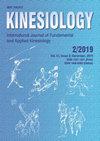Non-invasive assessment of short and ultra-short heart rate variability during different physical and physiological tests
IF 0.9
4区 医学
Q4 REHABILITATION
引用次数: 2
Abstract
The main aim of the present study was to determine the short- and ultra-short-term heart rate variability (HRV) during different physical and physiological tests and to compare HRV to different performance levels. The latter aim was to compare participants’ short- and ultra-short-term heart rate variability before-duringpost- tests. Our hypothesis was that there would be a significant difference between test performance and HRV parameters, and the high performing group would have significantly higher HRV parameters than the low performing group. Fifty-three healthy men (Mage=26.9±4 years, Mheight=177.9±5.7 cm; Mweight=77.8±8.7 kg) were recruited in the current study. We completed the data collection procedure for each participant in four consecutive days. On day-1, anthropometric measurements were conducted and then participants performed isokinetic tests. On day-2, participants performed anaerobic tests; on day-3 equilibrium tests, and on day-4 aerobic capacity tests. The HRV records of all participants were obtained before, during and after all these tests. Based on the participants’ performance, they were divided into two groups: participants in G1 had lower performance and those in G2 higher performance. A two-way repeated measures ANOVA yielded significant differences in HRV values obtained in the four different tests. There was a significant difference between fitness test performance and the variation of short- and ultra-short-term HRV parameters. Also, significant differences in HRV values before, during, and after the testing were observed. Key words: autonomic nervous system, heart rate variability, physical and physiological tests在不同的生理和生理测试中对短和超短心率变异性的无创评估
本研究的主要目的是确定不同身体和生理测试期间的短期和超短期心率变异性(HRV),并将HRV与不同表现水平进行比较。后一个目的是比较参与者在测试前和测试后的短期和超短期心率变异性。我们的假设是,测试表现和HRV参数之间存在显著差异,高表现组的HRV参数明显高于低表现组。本研究招募了53名健康男性(Mage=26.9±4岁,Mheight=177.9±5.7 cm;Mweight=77.8±8.7 kg)。我们在连续四天内完成了每位参与者的数据收集程序。在第1天,进行人体测量,然后参与者进行等速测试。在第2天,参与者进行厌氧测试;在第3天的平衡测试和在第4天的有氧能力测试中。所有参与者的HRV记录都是在所有这些测试之前、期间和之后获得的。根据参与者的表现,他们被分为两组:G1组参与者表现较低,G2组参与者表现较高。双向重复测量方差分析在四种不同的测试中获得的HRV值存在显著差异。适应度测试性能与短期和超短期HRV参数的变化之间存在显著差异。此外,在测试之前、期间和之后,观察到HRV值的显著差异。关键词:自主神经系统、心率变异性、身体和生理测试
本文章由计算机程序翻译,如有差异,请以英文原文为准。
求助全文
约1分钟内获得全文
求助全文
来源期刊

Kinesiology
REHABILITATION-SPORT SCIENCES
CiteScore
1.90
自引率
8.30%
发文量
16
审稿时长
>12 weeks
期刊介绍:
Kinesiology – International Journal of Fundamental and Applied Kinesiology (print ISSN 1331- 1441, online ISSN 1848-638X) publishes twice a year scientific papers and other written material from kinesiology (a scientific discipline which investigates art and science of human movement; in the meaning and scope close to the idiom “sport sciences”) and other adjacent human sciences focused on sport and exercise, primarily from anthropology (biological and cultural alike), medicine, sociology, psychology, natural sciences and mathematics applied to sport in its broadest sense, history, and others. Contributions of high scientific interest, including also results of theoretical analyses and their practical application in physical education, sport, physical recreation and kinesitherapy, are accepted for publication. The following sections define the scope of the journal: Sport and sports activities, Physical education, Recreation/leisure, Kinesiological anthropology, Training methods, Biology of sport and exercise, Sports medicine and physiology of sport, Biomechanics, History of sport and Book reviews with news.
 求助内容:
求助内容: 应助结果提醒方式:
应助结果提醒方式:


